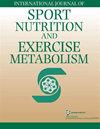英国陆军军官学员训练期间的营养和体育活动:第一部分-能量平衡和能量可用性。
IF 3
3区 医学
Q2 NUTRITION & DIETETICS
International journal of sport nutrition and exercise metabolism
Pub Date : 2022-04-07
DOI:10.1123/ijsnem.2021-0190
引用次数: 3
摘要
军事训练的特点是日常能量消耗高,难以与能量摄入匹配,可能导致负能量平衡(EB)和低能量可用性(EA)。本研究的目的是量化英国陆军军官学员训练期间的EB和EA。13名(7名女性)军官学员(平均±SD:年龄24±3岁)自愿参加。EB和EA是通过三个训练阶段的能量摄入(食物称重和食物日记)和能量消耗(双重标记水)来估计的:9天的营地(CAMP), 5天的实地演习(FEX), 9天的营地和实地训练(MIX)混合。变量按病情和性别进行比较,采用重复测量方差分析。与CAMP(-692±506 kcal/day)相比,FEX期间阴性EB最大(-2,197±455 kcal/day);p < 0.001)和MIX(-1,280±309千卡/天;P < 0.001)。CAMP组EA最高(23±10 kcal·kg游离脂肪质量[FFM]-1·day-1), FEX组EA最高(1±16 kcal·kg FFM-1·day-1);p = .002)和MIX(10±7 kcal·kg FFM-1·day-1;p = .003), FEX与MIX无显著差异(p = .071)。在任何情况下,EB (p = .375)和EA (p = .385)的性别间无明显差异。这些数据可用于为军事训练期间管理EA和EB的循证战略提供信息,并提高军事人员的健康和绩效。本文章由计算机程序翻译,如有差异,请以英文原文为准。
Nutrition and Physical Activity During British Army Officer Cadet Training: Part 1-Energy Balance and Energy Availability.
Military training is characterized by high daily energy expenditures which are difficult to match with energy intake, potentially resulting in negative energy balance (EB) and low energy availability (EA). The aim of this study was to quantify EB and EA during British Army Officer Cadet training. Thirteen (seven women) Officer Cadets (mean ± SD: age 24 ± 3 years) volunteered to participate. EB and EA were estimated from energy intake (weighing of food and food diaries) and energy expenditure (doubly labeled water) measured in three periods of training: 9 days on-camp (CAMP), a 5-day field exercise (FEX), and a 9-day mixture of both CAMP and field-based training (MIX). Variables were compared by condition and gender with a repeated-measures analysis of variance. Negative EB was greatest during FEX (-2,197 ± 455 kcal/day) compared with CAMP (-692 ± 506 kcal/day; p < .001) and MIX (-1,280 ± 309 kcal/day; p < .001). EA was greatest in CAMP (23 ± 10 kcal·kg free-fat mass [FFM]-1·day-1) compared with FEX (1 ± 16 kcal·kg FFM-1·day-1; p = .002) and MIX (10 ± 7 kcal·kg FFM-1·day-1; p = .003), with no apparent difference between FEX and MIX (p = .071). Irrespective of condition, there were no apparent differences between gender in EB (p = .375) or EA (p = .385). These data can be used to inform evidenced-based strategies to manage EA and EB during military training, and enhance the health and performance of military personnel.
求助全文
通过发布文献求助,成功后即可免费获取论文全文。
去求助
来源期刊
CiteScore
5.00
自引率
8.00%
发文量
50
审稿时长
6-12 weeks
期刊介绍:
The International Journal of Sport Nutrition and Exercise Metabolism (IJSNEM) publishes original scientific investigations and scholarly reviews offering new insights into sport nutrition and exercise metabolism, as well as articles focusing on the application of the principles of biochemistry, physiology, and nutrition to sport and exercise. The journal also offers editorials, digests of related articles from other fields, research notes, and reviews of books, videos, and other media releases.
To subscribe to either the print or e-version of IJSNEM, press the Subscribe or Renew button at the top of your screen.

 求助内容:
求助内容: 应助结果提醒方式:
应助结果提醒方式:


